Historical Overview
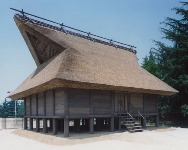 |
A 5th century reconstruction of a store house in Naniwa |
|---|
Kofun Period (ca. late 3rd Century ~ late 6th Century)
Relations with China and the Korean peninsula grew and Naniwazu port was developed as an entryway into ancient Japan for visitors from the Asian continent. Naniwazu served as a base for the arrival and departure of foreign envoys. Various cultures and technologies such as ceramics, forging, construction, engineering, and religion were brought in by the Chinese and Koreans, which then eventually spread all over Japan.
Huge tombs, such as Emperor Nintoku's Imperial Mausoleum, appeared in this age around the Osaka plains and were the symbol of royal authority. Various civil engineering projects were actively carried out such as the excavation of Naniwa Horie canal, so that the Yamato River would flow south to the port, and the preparation of roads to Sakai and Yamato.
Huge warehouses were constructed and Osaka became increasingly more important as a commercial trading city based on Naniwazu.
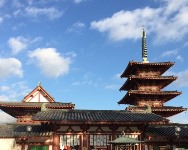 |
Shitennoji Temple |
|---|
The Asuka and Nara Periods (592 ~ 793)
Buddhism spread and Prince Shotoku constructed the Shitennoji Temple in 593. At that time, Naniwazu, the port from where Japanese envoys departed for the Asian continent to the courts of both the Sui and Tang Dynasties of China, became the largest base for international exchange.
In 645, Osaka was the stage for a great historical event, the “Taika-no-kaishin”. When Emperor Kotoku left Asuka, the then traditional capital city of Japan, it resulted to relocating the capital to “Naniwa Nagara Toyosaki-no-miya”, now modern-day Osaka, in order to oppose the immense pressure of the Sui and Tang Empires. He quickly consolidated power and built the first phase Palace of “Naniwa-no-miya”.
Though the capital eventually returned to Nara, the second phase Palace of “Naniwa-no-miya” served as a sub-capital and continued to play a role as a gateway for international exchange.
The Heian and Kamakura Periods (794 ~ 1333)
Kawachi Lake was gradually filled in and became a fertile plain in this period in history. Many faithfuls went on pilgrimages to Kumano starting from Temma Bridge and Watanabezu port on the southern shore of Kitahama.
According to the Buddhist belief that Paradise was in the west, many believers visited Shitennoji Temple to view the sun set into the sea from the western gate. The pilgrimage route from Watanabezu through Shitennoji Temple and Sumiyoshi Taisha Shrine to Kumano was developed to attend to the needs of the throngs of believers who were coming and going. It also advanced the development of town roads.
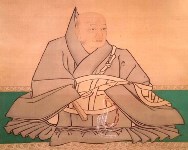 |
Rennyo |
|---|
The Muromachi Period (1334 ~ 1573)
Rennyo, the 8th head priest of “Jodo Shinshu (True Pure Land)” Buddhism, began the construction efforts of the Ishiyama Gobo, which later became Ishiyama Honganji Temple. In 1496, Osaka Castle was erected on this site. The name “Osaka” was derived from the tip of the “Uemachi Daichi”.
After that, the area encompassing Gobo prospered as a temple town and the base of present day Osaka was born. Nobunaga Oda looked upon Uemachi Daichi as a strategic area that provided great defense from enemy attacks and had a fine view of the surrounding region in which he said, "Osaka is the best place in Japan". Because this area was blessed with water from the Yamato and Yodo rivers, and with a long history of international exchange, it was believed that to control Uemachi Daichi was to control the rest of Japan and the world.
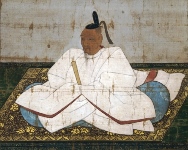 |
Hideyoshi Toyotomi |
|---|
The Azuchi and Momoyama Periods (1574 ~ 1607)
Kennyo, the 11th head priest of Ishiyama Honganji Temple, transferred control of the temple to Nobunaga Oda in 1580. Following in the steps of Nobunaga, Hideyoshi Toyotomi unified Japan from his base in Osaka and built Osaka Castle on the site of Ishiyama Honganji Temple.
The Higashi Yokobori river, Nishi Yokobori river, Awahori river, and other rivers were excavated to make Osaka a base for marine transportation. Many merchants came to Osaka to work in the cotton, oil, medicine, and metalworking industries. Also, overseas trading was emphasized as merchants from Osaka visited remote ports in South East Asia.
Hideyoshi's castle town of Osaka, however, was burned to the ground in the Osaka Winter and Summer Battles of 1614 and 1615.
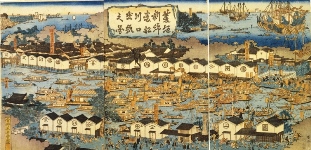 |
Sailing of Cotton-Loading Boats |
|---|
The Edo Period (1608 ~ 1867)
Osaka was restored from the ashes of war into an economic hub and became known as the “Kitchen of Japan” during the Edo era.
Osaka became an important base for transportation where goods from all over Japan were gathered and shipped. Osaka flourished as the largest economic city in Japan connected with international trading. The price in the Dojima Rice Market was recognized as the standard price for the nation.
Along with trading, the traditional performing arts were also beginning to bloom such as the Ningyo Joruri puppet theatre (※Developed in Osaka, Ningyo Joruri is widely known as Bunraku and is inscribed in 2008 on UNESCO's Representative List of the Intangible Cultural Heritage of Humanity). The combination of Gidayu Takemoto’s unique narrative chanting and Monzaemon Chikamatsu’s ingenious script writing helped make Ningyo Joruri into a major success that was well admired by the local residents. Literature began to gain recognition through the creative works composed by authors like Saikaku Ihara and Akinari Ueda.
Education also had many successes with the establishment of the Kaitokudo and Tekijuku schools. Nakamoto Tominaga, who studied at Kaitokudo, developed a unique school of philosophy concerning the principles of the world. He discovered many peculiar cultural patterns and had a profound effect on the world of thought at that time. Many citizen scholars, such as Banto Yamagata, who was known as a staunch rationalist, appeared one after the other on the social scene during this period.The Tekijuku, established by Koan Ogata, was a school for studying Western sciences and medicine. Its students included Keisuke Ootori and Yukichi Fukuzawa, who actively participated in efforts striving for government reforms during the final days of the Tokugawa regime. The Tekijuku was located near Doshomachi, the center of medical commerce in Japan, and many talented individuals coming from all parts of the country gathered in Osaka to study sciences freely.
Osaka, Japan’s kitchen, attracted many visitors, where various goods were traded and the dynamic growth in literary arts, education, and science took place. The diverse cultural aspects of the Edo period still provides an incredible presence in today’s Osaka.

